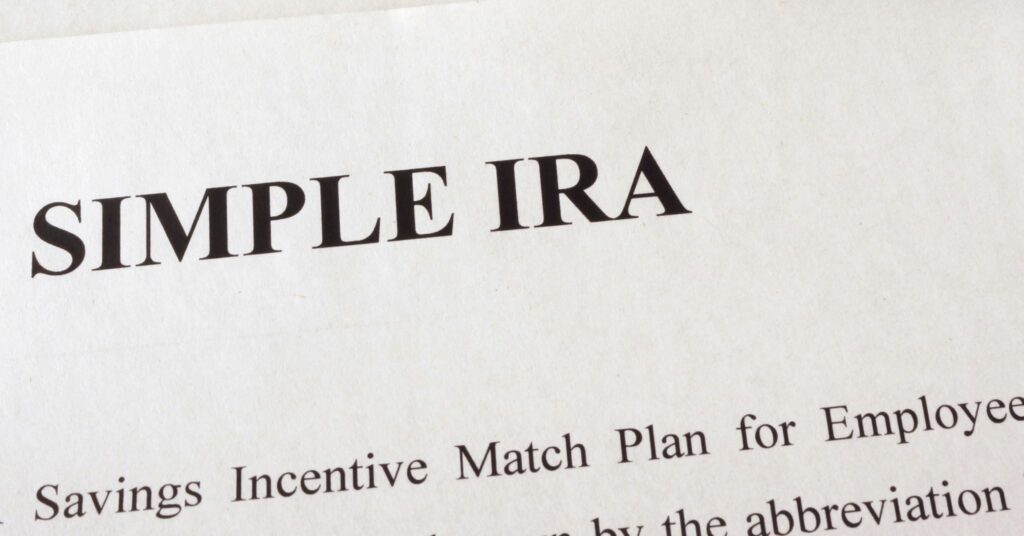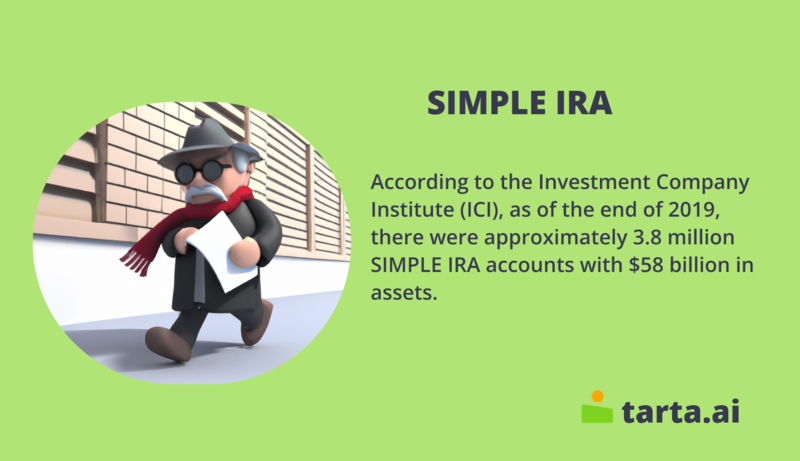Things You Should Know About Savings Incentive Match Plan for Employees (SIMPLE) IRA

PHOTO: m1.com
What is a SIMPLE IRA?
A SIMPLE IRA (Savings Incentive Match Plan for Employees) is a type of retirement plan that allows small businesses with fewer than 100 employees to offer a retirement savings plan to their employees. It is a tax-deferred plan that allows both employers and employees to make contributions toward retirement savings.
One key advantage of a SIMPLE IRA is that it has low administrative costs compared to other types of retirement plans. It is also relatively easy to set up and maintain, making it a good option for small businesses that want to offer a retirement plan to their employees but do not have the resources to administer a more complex plan.
Overall, a SIMPLE IRA can be a good option for small businesses and their employees to save for retirement with tax advantages and low administrative costs.
Advantages of a SIMPLE IRA
Are you a small business owner or an employee looking to save for retirement? If so, you may want to consider a SIMPLE IRA (Savings Incentive Match Plan for Employees). In this part of the article, we will explore the advantages of a SIMPLE IRA, including easy administration, tax-deferred contributions, and immediate vesting for employee contributions. Read on to learn more about why a SIMPLE IRA might be the right retirement plan for you.
There are several advantages of a SIMPLE IRA (Savings Incentive Match Plan for Employees), including:
- Easy to administer: A SIMPLE IRA is relatively easy to set up and maintain, making it a good option for small businesses that do not have the resources to administer a more complex retirement plan.
- Low administrative costs: SIMPLE IRAs have lower administrative costs than other types of retirement plans, making them a cost-effective option for small businesses.
- Tax-deferred contributions: Contributions made to a SIMPLE IRA are tax-deductible, which can help to reduce taxable income for both the employer and employee.
- Employer contributions: Employers are required to either make a matching contribution to an employee's account or a non-elective contribution of 2% of the employee's salary, which can help to encourage employees to save for retirement.
- Employee contributions: Employees can also make their own contributions to their SIMPLE IRA, up to a certain annual limit, which can help to further grow their retirement savings.
- Immediate vesting: Employee contributions to a SIMPLE IRA are always immediately vested, meaning that the employee has ownership of the funds from day one.
- Favorable vesting rules: Employer contributions to a SIMPLE IRA are either immediately vested or become fully vested after two years of service, which is generally more favorable to employees than other types of retirement plans.
Overall, a SIMPLE IRA can be a good option for small businesses and their employees to save for retirement with tax advantages and low administrative costs.

Who is eligible to participate in a SIMPLE IRA?
Eligibility to participate in a SIMPLE IRA (Savings Incentive Match Plan for Employees) depends on the employee and the employer. Here are some eligibility requirements:
- Employee eligibility: Employees who have earned at least $5,000 in any two preceding years and are expected to earn at least $5,000 in the current year are generally eligible to participate in a SIMPLE IRA.
- Employer eligibility: The employer must have 100 or fewer employees who received at least $5,000 in compensation during the preceding year. Employers who already maintain another qualified retirement plan may still be eligible to establish a SIMPLE IRA plan.
- Timeframe for enrollment: Employees must be given the opportunity to enroll in the SIMPLE IRA plan within 60 days of their hire date or within 60 days of when the plan is established, whichever is later.
NOTE
Employers who are not required to offer a SIMPLE IRA plan, and those who do offer it must make contributions to employees' accounts either through a matching contribution or a non-elective contribution. If you are an employee or employer interested in a SIMPLE IRA, it is recommended to speak with a financial advisor or tax professional to determine if it is the right retirement plan for you.
How to set up a SIMPLE IRA?
Step | Description |
1 | Determine eligibility: Confirm that the employer has 100 or fewer employees who received at least $5,000 in compensation during the preceding year. |
2 | Choose a financial institution: Select a trustee or custodian to hold the plan assets, such as a bank, brokerage firm, or mutual fund company. |
3 | Adopt a written plan document: Draft a written plan document that outlines the terms and conditions of the plan, including eligibility requirements, contribution limits, and vesting schedules. |
4 | Notify employees: Provide eligible employees with a summary plan description (SPD) that explains the plan's features and requirements. Allow employees at least 60 days to review the SPD and enroll in the plan. |
5 | Make contributions: Decide on either a matching contribution or a non-elective contribution to employees' SIMPLE IRA accounts. Make contributions no later than the due date of the employer's tax return, including extensions. |
6 | Enroll in a payroll deduction plan: Employees who choose to participate in the plan must complete a salary reduction agreement to authorize the employer to withhold a portion of their salary to contribute to their SIMPLE IRA account. |
7 | Maintain plan records: Keep accurate records of all plan contributions, distributions, and participant information. |
Fact
A survey by the Transamerica Center for Retirement Studies found that 29% of small business owners offered a SIMPLE IRA plan to their employees in 2020.
The contribution limits for a SIMPLE IRA
The contribution limits for a SIMPLE IRA (Savings Incentive Match Plan for Employees) are set by the IRS and are subject to change each year. Here are the contribution limits for 2023:
- Employee contributions: Employees can contribute up to $14,000 in 2023, up from $13,500 in 2022. Employees who are age 50 or older by the end of the year can make an additional catch-up contribution of $3,000 in 2023, up from $3,000 in 2022.
- Employer contributions: Employers are required to make either a matching contribution or a non-elective contribution to employees' SIMPLE IRA accounts. The employer may choose to match employee contributions dollar for dollar up to 3% of the employee's compensation or make a non-elective contribution equal to 2% of the employee's compensation, regardless of whether the employee makes contributions to the plan. The maximum employer contribution is $9,720 in 2023, up from $9,240 in 2022.
NOTE
The combined employer and employee contributions cannot exceed $58,000 in 2023, up from $57,000 in 2022. These limits are subject to change and may be adjusted in future years based on inflation. If you have questions about the contribution limits for a SIMPLE IRA, it is recommended to speak with a financial advisor or tax professional.
How is a SIMPLE IRA different from other types of retirement plans?
A SIMPLE IRA (Savings Incentive Match Plan for Employees) is a type of retirement plan that is designed for small businesses with fewer than 100 employees. Here are some ways that a SIMPLE IRA differs from other types of retirement plans:
- Contribution limits: The annual contribution limits for a SIMPLE IRA are lower than other types of retirement plans, such as 401(k) plans or SEP-IRAs. In 2023, employees can contribute up to $14,000 to a SIMPLE IRA, and those aged 50 or over can make an additional catch-up contribution of $3,000. Employers can either match employee contributions up to 3% of their salary or make a non-elective contribution of 2% of their salary.
- Eligibility requirements: A SIMPLE IRA is only available to small businesses with fewer than 100 employees, whereas other types of retirement plans may have different eligibility requirements. For example, a 401(k) plan is available to any size business, while a SEP-IRA is typically used by self-employed individuals or small business owners.
- Administrative costs: SIMPLE IRAs have lower administrative costs than other types of retirement plans, making them a good option for small businesses that may not have the resources to administer a more complex plan.
- Withdrawal penalties: Like other types of retirement plans, a SIMPLE IRA has withdrawal penalties if funds are withdrawn before the age of 59 1/2. However, the penalty for early withdrawal from a SIMPLE IRA is 25% if the funds are withdrawn within the first two years of participation in the plan, compared to a 10% penalty for early withdrawal from a 401(k) plan.
- Vesting requirements: Vesting rules for SIMPLE IRAs are generally more favorable to employees than other types of retirement plans. Employee contributions are always 100% vested, and employer contributions are either immediately vested or become fully vested after two years of service.
Overall, a SIMPLE IRA is a good option for small businesses and their employees to save for retirement with tax advantages and lower administrative costs.
- A SIMPLE IRA is a type of retirement plan designed for small businesses with 100 or fewer employees.
- Both employees and employers can make contributions to the plan, and contributions are tax-deductible for the employer and tax-deferred for the employee.
- Employee contribution limits for 2023 are $14,000, with an additional $3,000 catch-up contribution allowed for employees age 50 or older.
- Employer contribution limits for 2023 are 2% of the employee's compensation or a dollar-for-dollar match up to 3% of the employee's compensation.
- The combined employee and employer contributions cannot exceed $58,000 in 2023.
- Setting up a SIMPLE IRA involves determining eligibility, choosing a financial institution, adopting a written plan document, notifying employees, making contributions, enrolling in a payroll deduction plan, and maintaining plan records.
- Advantages of a SIMPLE IRA include lower administrative costs and easier plan administration compared to other retirement plans.
- However, there are also some disadvantages to consider, such as lower contribution limits compared to other retirement plans and the requirement for employers to make contributions to employee accounts.
- It's important to consult with a financial advisor or tax professional to determine if a SIMPLE IRA is the right retirement plan for your business and to ensure that the plan is set up and administered properly.
FAQ
What is a SIMPLE IRA?
A SIMPLE IRA (Savings Incentive Match Plan for Employees) is a type of retirement plan for small businesses with 100 or fewer employees.
Who can contribute to a SIMPLE IRA?
Both employees and employers can make contributions to a SIMPLE IRA.
What are the contribution limits for a SIMPLE IRA in 2023?
Employee contribution limits for 2023 are $14,000, with an additional $3,000 catch-up contribution allowed for employees age 50 or older. Employer contribution limits for 2023 are 2% of the employee's compensation or a dollar-for-dollar match up to 3% of the employee's compensation. The combined employee and employer contributions cannot exceed $58,000 in 2023.
How do I set up a SIMPLE IRA?
To set up a SIMPLE IRA, you need to determine eligibility, choose a financial institution, adopt a written plan document, notify employees, make contributions, enroll in a payroll deduction plan, and maintain plan records.
What are some advantages of a SIMPLE IRA?
Advantages of a SIMPLE IRA include lower administrative costs, easier plan administration, and tax-deductible contributions for employers and tax-deferred contributions for employees.